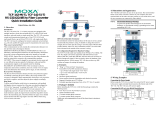
Introduction
TCC-120/120I User’s Guide 1-3
Built-in RS-485 ADDC™ Intelligence
ADDC™ (Automatic Data Direction Control), a Moxa leading
technology, uses a clever hardware solution to take care of the RS-485
data flow control problem. ADDC™ is a hardware data flow solution
that automatically senses and controls data direction, making the
handshaking signal method unnecessary.
Isolation
Moxa’s electrical isolation technology uses two photo couplers to
create a gap in each electrical signal. One photo coupler transforms
the electrical signal into a light signal, which is transmitted across a
small gap, and then the other photo coupler transforms the light signal
back into an electrical signal. In this way, the two electrical circuits
are completely isolated from each other, limiting the damage that
could otherwise be caused by power surges in the electrical signal.
Reverse Power Protection
The Reverse Power Protection feature provides extra protection
against accidentally connecting the power cables to the wrong
terminal. The converter is designed to automatically detect which
power wire is positive and which is negative, and then adjust the
power supply accordingly.
DIP Switch Selectable Terminator
For many products of this type, the termination resistor is set by a
jumper located inside the
product’s casing, so that the user must
open the casing to disable or change the resistor’s strength.
Moxa offers a better solution. The TCC-120/120I’s terminator
is set with a DIP Switch located on the outside of the
converter’s casing.
























